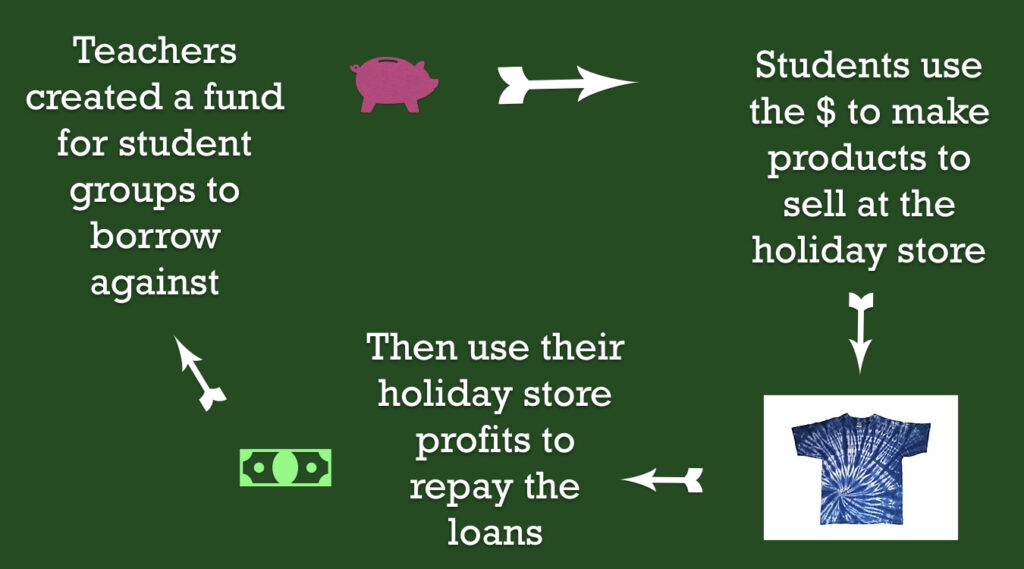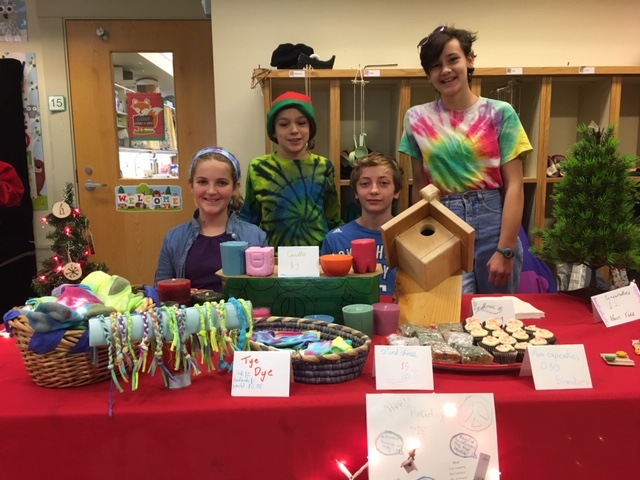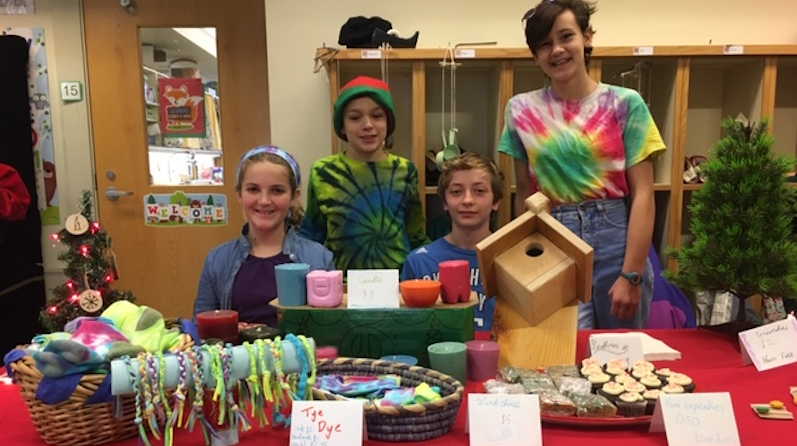Mettawee Community School, in West Pawlet VT, loves tradition. They’re a small, tight-knit school in a rural area, and home to two very important traditions: the annual Christmas holiday fair, and the sixth grade trip to Boston. And in order to address inequity in one tradition, they developed a unique solution that tied the two together. Mettawee’s sixth graders staff pop-up stores at the holiday fair, selling handmade items. To make the items, students can draw a loan from the in-school “bank”, of up to fifty dollars. They learn about contracts, and legal signatures, and take it very, very seriously. They know the bank must be paid back by 11am on the day of the fair, and that at the end, all profits from the day are pooled together and divided equally between all students as Boston spending money.
Economics, equity, pop-up stores and group tie-dye. Here’s how it all fits together.

Leveling the field trip experience
Students in the rural Vermont towns that make up Mettawee’s school district eagerly anticipate the annual sixth grade trip to Boston. For some of them, it’s their first time in a big city. But as anyone who’s chaperoned a field trip can tell you: students have access to wildly different amounts of spending money. And that can cast a pall over the experience. It’s an equity issue. So Mettawee’s sixth grade teachers put their heads together and figured out how to level the field trip playing field in an authentic, learning-appropriate manner. Teachers tell the sixth graders:
“You will all have the same amount of spending money. What’s more — you will earn it.”

As students advance through each grade, the annual Christmas holiday fair is the event of the season. It’s a genuinely joyous occasion. It features an intriguing rummage sale of goodies ranging in price from twenty-five cents to a full dollar, and a hallway of sixth grade pop-up shops. The shops all feature handmade items: tie-dye shirts, candles, birdhouses, dreamcatchers, baked goods, wind chimes, jewelry and tea lights. Holiday carols pipe gently from a side room, and each classroom of Mettawee students takes turns perusing the available goodies. Many students do their full holiday shopping that morning, finding trinkets and baubles at incredibly reasonable prices for family members. Teachers and community volunteers even provide on-site gift wrapping.
But as every small business owner knows, in order to sell product, you have to make product.
And that’s where the bank comes in.
Educators Patty Lea and Alison Zylstra serve as the in-school savings and loan department. Each group of sixth graders can borrow up to fifty genuine American dollars from the bank, with which to produce their products. However, the process is very formal, and ties to learning goals. Students first arrange an interview with the two bankers: a specific time and date to sit down together and talk business. The students must arrive with a business plan, specifying what they’re going to produce, what materials they’re going to need, how much materials cost, what their sale prices will be, the name of their business, and their proposed advertising. Lea and Zylstra review the business plan with students at the appointment, asking questions and prompting deeper consideration.
Once the business plan meets with the bank’s approval, everyone signs a formal contract, specifying how much is being loaned, and that the students understand they have until 11am on the day of the holiday fair to repay the funds. Not all groups take out the full amount on offer, and watching the students realize they should take out only as much as they really need, is part of the process. So too, is the idea of the contract itself. For most sixth graders, this is the first exposure they’ve had to contracts, and a lengthy discussion on the nature of legally binding contracts and who and why you enter into them is provided free of charge. Students sign their names — and for many of them, they have to practice their signature in advance, to meet with approval.
After that, they get to work.
The students have time during the school day to work on their holiday sale products. Part of the bank’s requirement for a loan is that each group must maintain a calendar, indicating when they’ll be working on which parts of the process, and a journal, documenting what they accomplish at each workshop. Additionally, the bank arranges for consultations from the library media specialist on the language of a good advertisement, and from former sixth graders, who offer advice to the new crop of business owners.
The sixth graders have all shopped and participated in the holiday fair as younger students, and that makes them aware just how much is riding on a successful table.
December rolls around, and excitement builds for the holiday fair. The sixth graders begin setting up their tables early that morning, laying out their wares, setting up their signs, putting up decorations and eagerly awaiting the crush of first customers. Shoppers begin to arrive, and the fair gets underway. It’s a mad whirl of students digging for treasures, punctuated by the sharp tear of wrapping paper and the squeak of scotch tape.

Eleven a.m., the golden hour, approaches. Every so often a student darts away from their table, cash in hand, hot-footing it over to find Lea. Lea is the day’s banker-in-charge. She counts out their cash and checks it against the loan paperwork. Then double-checks it.
As younger students who have shopped the student marketplace, these sixth graders are ready. They’ve eagerly anticipated their turn behind the tables, and they’re ready to take it on with the utmost seriousness. And inevitably, every student that we talked to said, “It’s so much more difficult than it looks.”
But it works.
At the conclusion of this year’s holiday fair, all student groups repaid their loans. Then the bank gathered all the remaining profit into one pool and divides it equally between all 25 sixth graders. This June, when Mettawee Community School descends on the Boston metropolis, each student will be carrying thirty-three dollars in spending money. And they’ll all know they earned every single penny of it.
“Trickledown empathy”
Students learn a ton about economics over the course of the unit, and pick up a number of transferable skills. But they also learn something else: empathy. Says Patty Lea,
“Many kids will say that they have more respect, at the end, for their self-employed parents. Because they have small businesses. And they understand that it takes a lot of organization, time, patience and money, to run a business.”
How do you address field trip equity?
Very few units can school can accomplish so much. Sixth graders learn necessary economics and math concepts. They engage in authentic and purposeful learning that levels the socio-economic playing field on a class trip. And their efforts culminate in a community-level tradition that sparks pride, ownership and efficacy for the whole school.
Educator Patty Lea offers some advice to other teachers looking to try out the in-school bank experience.
Tell us about your school wide traditions that fuel student motivation across the years.



It’s an amazing blog post, and it is really helpful as well.
Excellent ! I personally like your blog and waiting for more articles like this
Can you be more specific about the content of your article? After reading it, I still have some doubts. Hope you can help me.